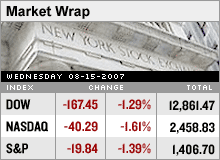The disquiet on Wall Street showed no signs of letting up today as the Dow Jones industrial average closed below 13,000 for the first time since April and the Standard & Poor?s 500-stock index erased its gains for the year.
The recent losses have been all the more painful for investors considering how much the stock market has slipped over the last few weeks. Less than a month ago, Wall Street was on a record-setting streak. The Dow crossed 14,000 for the first time, and the S.& P. 500 reached its highest point ever on July 19.
But since then, the market has become overrun with concern that tighter borrowing standards will make it more difficult for investors to raise the kind of cash that has fed the steady rise in stock values since 2003.
The Dow finished the day down 167.45 points, or 1.3 percent, at 12,861.47. The S.& P. 500 closed down 1.4 percent, at 1,406.70, and is now down 0.8 percent for the year. The Nasdaq composite index fell 1.6 percent.
The stock market?s slump has come as recent readings on the health of the economy suggest that the outlook is improving. Investors largely ignored economic reports yesterday and today that suggested the economy is gaining momentum. The latest trade deficit figures showed that strong exports are likely to lift growth this year more than economists initially forecast. A separate report on manufacturing activity out today showed healthy production levels in the nation?s factories.
Though the latest economic readings indicate that growth is steady, they also make a rate cut by the Federal Reserve less likely. And a rate cut is what many on Wall Street have been hoping for, underscoring the growing disconnect between what economic indicators are saying about the health of the American economy and what is playing out in the stock market.
In another sign that a rate cut is not likely soon, the government reported today that while consumer price increases eased slightly last month, long-term readings on inflation suggest that the Fed is not facing pressure to lower its guard.
For the third consecutive month, the rate of core inflation over the last year ? a measurement of prices that the Fed favors because it excludes volatility-prone food and energy prices ? showed no improvement. It remained stalled at 2.2 percent, which supports the Fed?s assertion last week that ?a sustained moderation in inflation pressures has yet to be convincingly demonstrated.?
?The economic data we?ve received by itself suggests no need for the Fed to consider cutting rates,? said Dean Maki, chief United States economist for Barclays Capital. ?There?s ample reason for the Fed to be concerned about inflation risks.?
As lenders have made borrowing money more difficult and expensive lately, Wall Street went into retreat. Stock prices have fluctuated wildly and lost about 8 percent of their value since peaking on July 19. A number of large hedge funds have suffered sharp losses. This turbulence has led some on Wall Street to call for the Fed to lower rates to stave off a financial crisis.
But the Fed?s position is that the problems in financial and credit markets are not likely to spill over into the economy as a whole. And the central bank remains fixed on bringing inflation down further ? something it fears it cannot accomplish if it lowers rates now.
?If you say we just lowered interest rates because the financial markets are upset, people are going to say that?s Ben Bernanke bailing out Wall Street,? said Jan Hatzius, chief United States economist for Goldman Sachs. ?And clearly that?s not the perception they want.?
The Labor Department said today in its monthly survey of prices at the retail level that the consumer price index rose 0.1 percent in July after an increase of 0.2 percent in June. From July 2006 to July 2007, prices climbed 2.4 percent, compared with a 2.7 percent annual increase in June.
But core consumer prices showed no improvement. For the month, they rose 0.2 percent, the same as in June. On a year-over-year basis, they rose 2.2 percent, the same as in June and May.
?Inflation?s sticky,? said Joseph Brusuelas, chief United States economist with IdeaGlobal.
Falling energy costs helped keep inflation from climbing too rapidly over all. After rising considerably in the spring, the government said energy costs fell 1 percent in July, with a 1.7 percent drop in the cost of gasoline.
Price increases on other goods, however, remained elevated. Apparel costs jumped 0.4 percent in July after falling in the previous four months. Health care costs continued to rise, increasing 0.6 percent, compared with a rise of 0.4 percent in June. They were up 4.3 percent in the last year.










